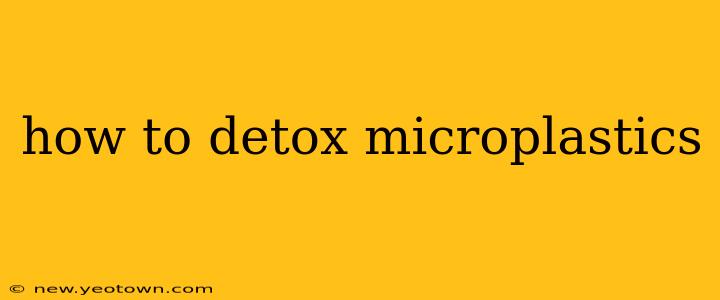Microplastics. The word itself sounds unsettling, conjuring images of tiny, invisible pollutants invading our bodies. And unfortunately, that image isn't far from the truth. These minuscule plastic particles are pervasive, infiltrating our food, water, and even the air we breathe. But the question many are asking is: how can we detox these insidious invaders? The truth is, there’s no single magic bullet, but a multi-pronged approach can significantly minimize your microplastic exposure and support your body's natural detoxification processes.
This journey isn't about a quick fix; it's about making sustainable lifestyle changes that protect your health and the planet. Let's explore some effective strategies.
What are Microplastics and How Do They Get into Our Bodies?
Before diving into detox methods, it's crucial to understand the enemy. Microplastics are tiny plastic particles less than 5 millimeters in diameter. They originate from the breakdown of larger plastic items like bottles and bags, as well as from synthetic clothing fibers and industrial processes. They're essentially everywhere – in our oceans, soil, and even the air.
We ingest these particles through contaminated food and water, inhale them through the air, and even absorb them through our skin. The long-term health effects of microplastic accumulation are still being researched, but concerns exist regarding potential inflammation, endocrine disruption, and damage to organs.
How Can I Reduce My Microplastic Intake?
This is arguably the most crucial step in the detoxification process: prevention. Reducing your exposure minimizes the burden on your body.
1. Choose Wisely: Food & Drink
- Prioritize whole, unprocessed foods: These are less likely to contain microplastics compared to processed foods packaged in plastic.
- Drink filtered water: Investing in a high-quality water filter can significantly reduce microplastic intake from tap water.
- Be mindful of seafood: Shellfish, in particular, tends to accumulate microplastics. Consider limiting your consumption or choosing sustainably sourced options.
- Avoid single-use plastics: This drastically reduces the amount of plastic that eventually breaks down into microplastics. Opt for reusable water bottles, shopping bags, and food containers.
2. Protect Yourself from Airborne Microplastics
While less discussed, airborne microplastics are a significant source of exposure.
- Consider air purifiers: High-efficiency particulate air (HEPA) filters can help capture some microplastics from the air.
- Reduce exposure to dusty environments: Construction sites, heavily trafficked areas, and places with significant plastic debris in the air increase your exposure.
3. Clothing Choices Matter
- Opt for natural fibers: Choose clothes made from cotton, linen, wool, or other natural materials over synthetic fabrics like polyester and nylon, which shed microplastics during washing.
- Wash clothes less frequently and at lower temperatures: This reduces the release of microplastics into wastewater. Consider using a laundry bag designed to capture microplastics.
What Can I Do to Support My Body's Natural Detoxification?
While you can't directly "detox" microplastics in the same way you might detox from a specific toxin, you can support your body's natural elimination processes.
1. Prioritize Gut Health
A healthy gut plays a vital role in overall health, including detoxification. A balanced microbiome can help improve digestion and the removal of waste products from the body.
- Eat a fiber-rich diet: Fiber helps move waste through your digestive system.
- Include probiotics: These beneficial bacteria contribute to gut health.
2. Stay Hydrated
Water is essential for all bodily functions, including waste removal. Aim for adequate daily water intake.
3. Support Your Liver
The liver plays a crucial role in detoxification. A healthy liver is better equipped to handle environmental toxins.
- Eat a liver-supporting diet: Focus on nutrient-rich foods, and consider foods known for their liver-protective properties. (Consult with a healthcare professional before making significant dietary changes.)
4. Manage Stress
Chronic stress can negatively impact detoxification processes. Incorporate stress-reducing activities like yoga, meditation, or spending time in nature.
Are There Specific Detox Methods for Microplastics?
Currently, there's no clinically proven, specific detox method for microplastics. The strategies above focus on reducing intake and supporting your body’s inherent ability to eliminate waste.
Can I test for microplastics in my body?
Testing for microplastics in the body is still under development and not readily accessible for the general public. Research in this area is ongoing.
This journey towards minimizing microplastic exposure is a marathon, not a sprint. By making informed choices and adopting a holistic approach, you can significantly reduce your exposure and support your body’s natural detoxification processes. Remember, a proactive, preventative approach is key to long-term health and well-being in a world increasingly impacted by microplastics.

